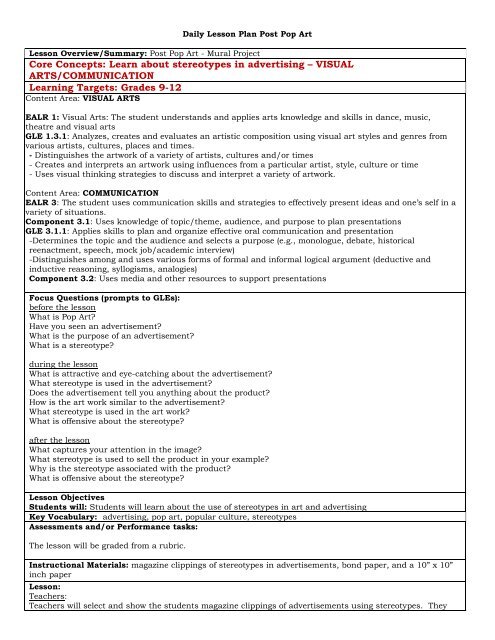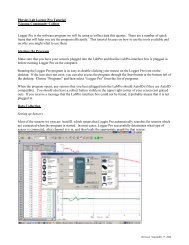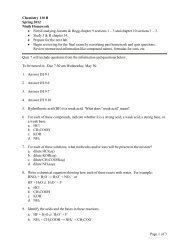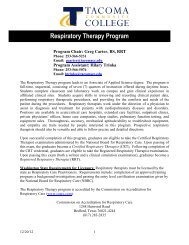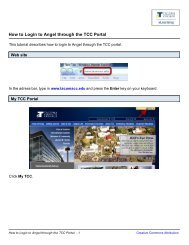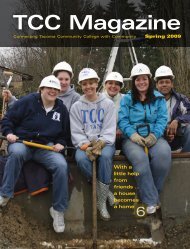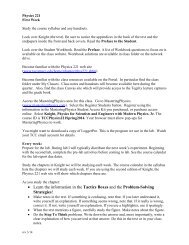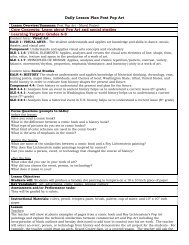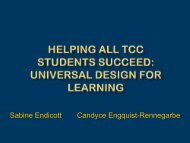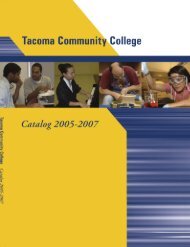Learn about stereotypes in advertising â VISUAL ARTS ...
Learn about stereotypes in advertising â VISUAL ARTS ...
Learn about stereotypes in advertising â VISUAL ARTS ...
You also want an ePaper? Increase the reach of your titles
YUMPU automatically turns print PDFs into web optimized ePapers that Google loves.
Daily Lesson Plan Post Pop ArtLesson Overview/Summary: Post Pop Art - Mural ProjectCore Concepts: <strong>Learn</strong> <strong>about</strong> <strong>stereotypes</strong> <strong>in</strong> advertis<strong>in</strong>g – <strong>VISUAL</strong><strong>ARTS</strong>/COMMUNICATION<strong>Learn</strong><strong>in</strong>g Targets: Grades 9-12Content Area: <strong>VISUAL</strong> <strong>ARTS</strong>EALR 1: Visual Arts: The student understands and applies arts knowledge and skills <strong>in</strong> dance, music,theatre and visual artsGLE 1.3.1: Analyzes, creates and evaluates an artistic composition us<strong>in</strong>g visual art styles and genres fromvarious artists, cultures, places and times.- Dist<strong>in</strong>guishes the artwork of a variety of artists, cultures and/or times- Creates and <strong>in</strong>terprets an artwork us<strong>in</strong>g <strong>in</strong>fluences from a particular artist, style, culture or time- Uses visual th<strong>in</strong>k<strong>in</strong>g strategies to discuss and <strong>in</strong>terpret a variety of artwork.Content Area: COMMUNICATIONEALR 3: The student uses communication skills and strategies to effectively present ideas and one’s self <strong>in</strong> avariety of situations.Component 3.1: Uses knowledge of topic/theme, audience, and purpose to plan presentationsGLE 3.1.1: Applies skills to plan and organize effective oral communication and presentation-Determ<strong>in</strong>es the topic and the audience and selects a purpose (e.g., monologue, debate, historicalreenactment, speech, mock job/academic <strong>in</strong>terview)-Dist<strong>in</strong>guishes among and uses various forms of formal and <strong>in</strong>formal logical argument (deductive and<strong>in</strong>ductive reason<strong>in</strong>g, syllogisms, analogies)Component 3.2: Uses media and other resources to support presentationsFocus Questions (prompts to GLEs):before the lessonWhat is Pop Art?Have you seen an advertisement?What is the purpose of an advertisement?What is a stereotype?dur<strong>in</strong>g the lessonWhat is attractive and eye-catch<strong>in</strong>g <strong>about</strong> the advertisement?What stereotype is used <strong>in</strong> the advertisement?Does the advertisement tell you anyth<strong>in</strong>g <strong>about</strong> the product?How is the art work similar to the advertisement?What stereotype is used <strong>in</strong> the art work?What is offensive <strong>about</strong> the stereotype?after the lessonWhat captures your attention <strong>in</strong> the image?What stereotype is used to sell the product <strong>in</strong> your example?Why is the stereotype associated with the product?What is offensive <strong>about</strong> the stereotype?Lesson ObjectivesStudents will: Students will learn <strong>about</strong> the use of <strong>stereotypes</strong> <strong>in</strong> art and advertis<strong>in</strong>gKey Vocabulary: advertis<strong>in</strong>g, pop art, popular culture, <strong>stereotypes</strong>Assessments and/or Performance tasks:The lesson will be graded from a rubric.Instructional Materials: magaz<strong>in</strong>e clipp<strong>in</strong>gs of <strong>stereotypes</strong> <strong>in</strong> advertisements, bond paper, and a 10” x 10”<strong>in</strong>ch paperLesson:Teachers:Teachers will select and show the students magaz<strong>in</strong>e clipp<strong>in</strong>gs of advertisements us<strong>in</strong>g <strong>stereotypes</strong>. They
will discuss the goals of advertisers, the commercial art style, and the use of <strong>stereotypes</strong>. Teachers willdiscuss the goals of Pop Art to elevate commercial art styles to high art styles, and consider the impact ofmass market<strong>in</strong>g, popular culture, and consumerism <strong>in</strong> our culture. They will show the students images<strong>in</strong>clud<strong>in</strong>g Roger Shimomura’s Abercrombie and Fitch (2003), Roy Lichtenste<strong>in</strong>’s Girl with a Ball (1961),Michael Ray Charles’s (Forever Free) Buy Black (1996), and others. The teacher will provide each studentwith magaz<strong>in</strong>e clipp<strong>in</strong>g of advertisements us<strong>in</strong>g <strong>stereotypes</strong> (Aunt Jemima, Ugly Duckl<strong>in</strong>g) and ask them toresearch the image. After the student has produced their 10” x 10” image and list of pros and cons <strong>about</strong>the advertisement, the teacher will display the student’s images <strong>in</strong> the classroom and lead a discussion<strong>about</strong> the content of the images. Teachers will affix a label on the back of each submission that <strong>in</strong>cludes thestudent’s name, age, and school. The deadl<strong>in</strong>e for submissions is January 5, 2011.Students:Students will glue a magaz<strong>in</strong>e clipp<strong>in</strong>g of a stereotype for an advertisement that is provided to them by theirteacher. They will glue an image of a stereotype from an advertisement from a magaz<strong>in</strong>e or newspaper on a10 x 10 <strong>in</strong>ch piece of paper. They will research the stereotype on the <strong>in</strong>ternet. They will type a list of theproblems with the stereotype and glue it next to the image on the same piece of paper. They will also list theeye catch<strong>in</strong>g aspects of the advertisement such as the clean design, readability, and vibrant color palette,and whether or not the advertisement tell the audience anyth<strong>in</strong>g <strong>about</strong> the product.Resources: Reth<strong>in</strong>k<strong>in</strong>g Schools - Education Resources for Equity and Justice, Fall/W<strong>in</strong>ter 2010-11 catalogue- http://www.reth<strong>in</strong>k<strong>in</strong>gschools.org/<strong>in</strong>dex.shtml, Lucy R. Lippard, Roger Shimomura; Stereotypes andAdmonitions, Seattle: Greg Kucera Gallery, 2004 (ISBN: 0-9704699-2-6); Professor Chris Witcombe (ArtDepartment of Sweet Briar College) provides l<strong>in</strong>ks to art history websites-www.witcombe.sbc.edu/ARTHL<strong>in</strong>ksLesson Reflection (your thoughts, ideas, and recommended changes to the lesson):The draw<strong>in</strong>gs will be part of a Paper Mural Project on display <strong>in</strong> the Gallery at Tacoma Community Collegefrom January 18, 2011 – May 3, 2011. There will be an award presented at the reception at 5:00 p.m. onJanuary 20, 2011.CATEGORY 4 Exemplary 3 Proficient 2 Ga<strong>in</strong><strong>in</strong>g Proficieny 1 M<strong>in</strong>imalSummary/Analysis/Synthesis Clearly andconciselysummarizes,analyzesandsythesizes<strong>in</strong>formationand ideasInvention (F<strong>in</strong>d<strong>in</strong>g Ideas)Br<strong>in</strong>gshis/her ownideas andpossibilities<strong>in</strong>to theassignment<strong>in</strong> a unique,<strong>in</strong>sightful,and orig<strong>in</strong>alwaySummarizesand analyzesthe<strong>in</strong>formationand ideasInteracts <strong>in</strong> acomplete butunorig<strong>in</strong>alway with theideasSummarizes<strong>in</strong>formation <strong>in</strong> amechanical wayDemonstrateslimited or partially<strong>in</strong>accurate<strong>in</strong>teraction with theideasDoes notaccurately andor adequatelysummarize<strong>in</strong>formationResponds <strong>in</strong> amanner that is<strong>in</strong>appropriateand unrelatedto therequirements
OrganizationStyleBuilds ideaslogically andclearly bydeterm<strong>in</strong><strong>in</strong>ghis/her owndirectionand flowUse oflanguage isprecise andspecificPartitions anddividesresponse totheassignment <strong>in</strong>a clear andlogical way,withtransitionsamong ideasUse oflanguage isappropriateOrders andorganizes <strong>in</strong> a waythat is<strong>in</strong>appropriate ot thepurposeUse of language isnot fully connectedto the requirementsand may be vagueand generalizedOrders andorganizes <strong>in</strong> amanner thatconfusesmean<strong>in</strong>gUse oflanguageunrelated tothe purposeand matterDeliveryVisual MaterialProfessional,captivat<strong>in</strong>g,expressive;uses voice todrawattention towhat isbe<strong>in</strong>g said;ma<strong>in</strong>ta<strong>in</strong>sconsistenteye contactArtisitc,creative,and <strong>in</strong>tegralto oralmessagePoised, calm;enunciatesclearly and isconversational<strong>in</strong> approach,shows eyecontactComplementsthe verbalmessage <strong>in</strong> aclear andpleas<strong>in</strong>gfashionLacks poise andcontrol, stiff andmechanical, maymumble, avoids eyecontactDoes notcomplement theverbal message andis not pleas<strong>in</strong>gDoes notrespondaudibly or withunderstandableenunciationIs unrelatedand easilydistracted


